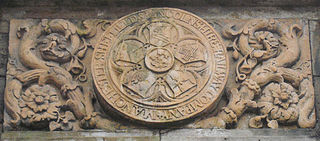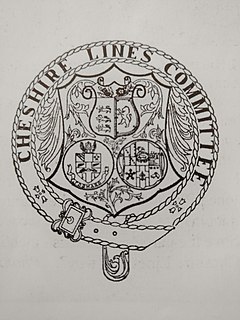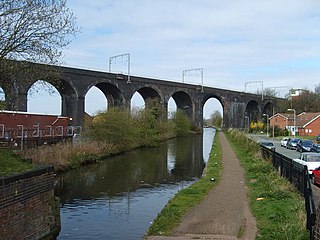Related Research Articles

The River Mersey is a river in the North West of England. Its name is derived from Old English and means "boundary river", possibly referring to its having been a border between the ancient kingdoms of Mercia and Northumbria. For centuries it has formed part of the boundary between the historic counties of Lancashire and Cheshire.

The London and North Western Railway was a British railway company between 1846 and 1922. In the late 19th century, the L&NWR was the largest joint stock company in the United Kingdom.

Liverpool Lime Street is a terminus railway station and the main station serving the city centre of Liverpool. Opened in August 1836, it is the oldest still-operating grand terminus mainline station in the world. A branch of the West Coast Main Line from London Euston terminates at the station, as does the original Liverpool and Manchester Railway. Journeys from Lime Street cover a wide range of destinations across England, Scotland, and Wales.

The Manchester, Sheffield and Lincolnshire Railway (MS&LR) was formed in 1847 when the Sheffield, Ashton-under-Lyne and Manchester Railway joined with authorised but unbuilt railway companies, forming a proposed network from Manchester to Grimsby. It pursued a policy of expanding its area of influence, especially in reaching west to Liverpool, which it ultimately did through the medium of the Cheshire Lines Committee network in joint partnership with the Great Northern Railway and the Midland Railway.

The Cheshire Lines Committee (CLC) was formed in the 1860s and became the second-largest joint railway in Great Britain. The committee, which was often styled the Cheshire Lines Railway, operated 143 miles (230 km) of track in the then counties of Lancashire and Cheshire. The railway did not get grouped into one of the Big Four during the implementation of the 1923 grouping, surviving independently with its own management until the railways were nationalised at the beginning of 1948. The railway served Liverpool, Manchester, Stockport, Warrington, Widnes, Northwich, Winsford, Knutsford, Chester and Southport with connections to many other railways.

Sir John Hawkshaw FRS FRSE FRSA MICE, was an English civil engineer. He served as President of the Institution of Civil Engineers 1862-63. His most noteworthy work is the Severn Tunnel.

Liverpool Exchange railway station was a railway station located in the city centre of Liverpool, England. Of the four terminal stations in Liverpool's city centre, Exchange station was the only station not accessed via a tunnel.

Whatstandwell railway station is a railway station owned by Network Rail and managed by East Midlands Railway. It serves the villages of Whatstandwell and Crich Carr in Derbyshire, England. The station is located on the Derwent Valley Line from Derby to Matlock.

St Helens and Runcorn Gap Railway was an early railway line owned by a company of the same name in Lancashire, England, which opened in 1833. It was later known as St Helens Railway. It ran originally from the town of St Helens to the area which would later develop into the town of Widnes. Branches were opened to Garston, Warrington and Rainford. The company was taken over by the London and North Western Railway in 1864. The line from St Helens to Widnes and the branch to Rainford are now closed, the latter terminating at the Pilkington Glass' Cowley Hill works siding near Gerard's Bridge, but part of the lines to Garston and to Warrington are still in operation.

Garston railway station was a railway station in the Garston district of Liverpool, England. The station was located on the Northern Line of the Merseyrail suburban rail network. The station was closed in 2006 when it was replaced by Liverpool South Parkway, which is a combined bus and rail interchange. The proximity of the stations was so close the platforms of South Parkway nearly merged onto the Garston station's platforms.

Liverpool South Parkway station is a railway station and bus interchange in the Garston district of Liverpool, England. It serves, via a bus link, Liverpool John Lennon Airport in the neighbouring suburb of Speke, as well as providing an interchange between main line services and the Merseyrail rapid transit/commuter rail network.

The Garston and Liverpool Railway line ran from the St Helens and Runcorn Gap Railway line at Garston Docks to Brunswick railway station, later to central Liverpool. The company was formed on 17 May 1861 and the line opened on 1 June 1864.

William Baker was a railway engineer.

The architecture of Liverpool is rooted in the city's development into a major port of the British Empire. It encompasses a variety of architectural styles of the past 300 years, while next to nothing remains of its medieval structures which would have dated back as far as the 13th century. Erected 1716–18, Bluecoat Chambers is supposed to be the oldest surviving building in central Liverpool.
Garston Dock railway station served Garston, Liverpool, Merseyside, England and Garston Docks. It was situated on the east side of Dock Road.

The former North Western Hotel is a historic building in Liverpool, England. It is located on the east side of Lime Street, fronting Lime Street railway station. Opened in 1871, it has also served as office space and student accommodation, and from 2018 is being restored as a hotel. The building is recorded in the National Heritage List for England as a designated Grade II listed building.
The following is a timeline of the history of the city of Liverpool, England.

John Holloway Sanders FRIBA was an architect based in England and chief architect of the Midland Railway until 1884.
William Lancaster Owen was a British civil engineer primarily with the Great Western Railway.

Lenton railway station was situated on the Midland Railway line on Derby Road in Lenton, Nottingham.
References
- ↑ "Marriages" . Liverpool Mail. England. 4 October 1873. Retrieved 20 February 2022– via British Newspaper Archive.
- ↑ "Mr. E.B. Thornhill" . Railway News. England. 9 September 1911. Retrieved 22 February 2022– via British Newspaper Archive.
- ↑ "Institution of Civil Engineer" . Yorkshire Post and Leeds Intelligencer. England. 7 May 1870. Retrieved 22 February 2022– via British Newspaper Archive.
- ↑ "Volunteer Corps" . Volunteer Service Gazette and Military Dispatch. England. 7 October 1893. Retrieved 22 February 2022– via British Newspaper Archive.